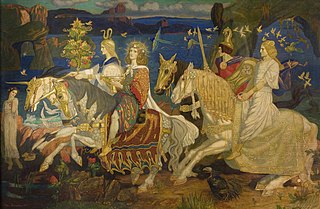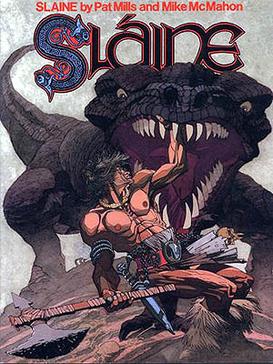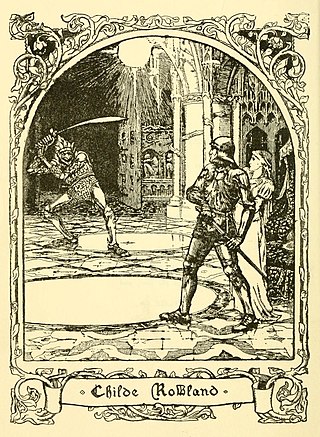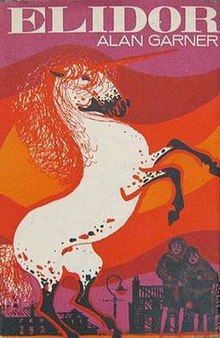
Alan Garner is an English novelist best known for his children's fantasy novels and his retellings of traditional British folk tales. Much of his work is rooted in the landscape, history and folklore of his native county of Cheshire, North West England, being set in the region and making use of the native Cheshire dialect.

The TuathaDé Danann, also known by the earlier name Tuath Dé, are a supernatural race in Irish mythology. Many of them are thought to represent deities of pre-Christian Gaelic Ireland.

Fionn mac Cumhaill, often anglicized Finn McCool or MacCool, is a hero in Irish mythology, as well as in later Scottish and Manx folklore. He is the leader of the Fianna bands of young roving hunter-warriors, as well as being a seer and poet. He is said to have a magic thumb that bestows him with great wisdom. He is often depicted hunting with his hounds Bran and Sceólang, and fighting with his spear and sword. The tales of Fionn and his fiann form the Fianna Cycle or Fenian Cycle, much of it narrated by Fionn's son, the poet Oisín.

Children's literature or juvenile literature includes stories, books, magazines, and poems that are created for children. Modern children's literature is classified in two different ways: genre or the intended age of the reader, from picture books for the very young to young adult fiction.

Manannán or Manann, also known as Manannán mac Lir, is a warrior and king of the Otherworld in Irish and Manx mythology who is associated with the sea and often interpreted as a sea god, usually as a member of the Tuatha Dé Danann.

Sláine is a comic hero that was first published in British magazine 2000 AD.
In the Mythological Cycle of early Irish literature, the four treasures of the Tuatha Dé Danann are four magical items which the mythological Tuatha Dé Danann are supposed to have brought with them from the four island cities Murias, Falias, Gorias, and Findias when they arrived in Ireland.

Lebor Gabála Érenn, Modern Irish spelling: Leabhar Gabhála Éireann) known in English as The Book of Invasions, is a collection of poems and prose narratives in the Irish language intended to be a history of Ireland and the Irish from the creation of the world to the Middle Ages. There are a number of versions, the earliest of which was compiled by an anonymous writer in the 11th century. It synthesised narratives that had been developing over the foregoing centuries. The Lebor Gabála tells of Ireland being settled six times by six groups of people: the people of Cessair, the people of Partholón, the people of Nemed, the Fir Bolg, the Tuatha Dé Danann, and the Milesians. The first four groups are wiped out or forced to abandon the island; the fifth group represents Ireland's pagan gods, while the final group represents the Irish people.

The Fál or Lia Fáil is a stone at the Inauguration Mound on the Hill of Tara in County Meath, Ireland, which served as the coronation stone for the King of Tara and hence High King of Ireland. It is also known as the Stone of Destiny or Speaking Stone. According to legend, all of the kings of Ireland were crowned on the stone up to Muirchertach mac Ercae, c. 500 AD.

Welsh mythology consists of both folk traditions developed in Wales, and traditions developed by the Celtic Britons elsewhere before the end of the first millennium. As in most of the predominantly oral societies Celtic mythology and history were recorded orally by specialists such as druids. This oral record has been lost or altered as a result of outside contact and invasion over the years. Much of this altered mythology and history is preserved in medieval Welsh manuscripts, which include the Red Book of Hergest, the White Book of Rhydderch, the Book of Aneirin and the Book of Taliesin. Other works connected to Welsh mythology include the ninth-century Latin historical compilation Historia Brittonum and Geoffrey of Monmouth's twelfth-century Latin chronicle Historia Regum Britanniae, as well as later folklore, such as the materials collected in The Welsh Fairy Book by William Jenkyn Thomas (1908).

Childe Rowland is a fairy tale, the most popular version written by Joseph Jacobs in his English Fairy Tales, published in 1890, based on an earlier version published in 1814 by Robert Jamieson. Jamieson's was repeating a "Scottish ballad", which he had heard from a tailor.
This is a bibliography of works about King Arthur, his family, his friends or his enemies. This bibliography includes works that are notable or are by notable authors.

"Childe Roland to the Dark Tower Came" is a narrative poem by English author Robert Browning, written on January 2, 1852, and first published in 1855 in the collection titled Men and Women. The poem is often noted for its dark and atmospheric imagery, inversion of classical tropes, and use of unreliable narration. Childe Roland, the only speaker in the poem, describes his journey towards "the Dark Tower", and his horror at what he sees on his quest. The poem ends when Roland finally reaches the tower, leaving his ultimate fate ambiguous.
Brehon is a term for a historical arbitration, mediative and judicial role in Gaelic culture. Brehons were part of the system of Early Irish law, which was also simply called "Brehon law". Brehons were judges, close in importance to the chiefs.

The Sword of Light or Claidheamh Soluis is a trope object that appears in a number of Irish and Scottish Gaelic folktales. The "Quest for sword of light" formula is catalogued as motif H1337.

Ralph de Gaël was the Earl of East Anglia and Lord of Gaël and Montfort. He was the leading figure in the Revolt of the Earls, the last serious revolt against William the Conqueror.
The Saga of Pliocene Exile is a series of science / speculative fiction books by Julian May, first published in the early 1980s. It consists of four books: The Many-Colored Land, The Golden Torc, The Nonborn King and The Adversary.

World Tales, subtitled "The Extraordinary Coincidence of Stories Told in All Times, in All Places" is a book of 65 folk tales collected by Idries Shah from around the world, mostly from literary sources. Some of the tales are very current, others are less well known.
Failinis [FAW IHN-ish] or Ṡalinnis/Shalinnis is a dog in the Mythological Cycle of Irish literature, belonging to Lugh Lámhfhada of the Tuatha Dé Danann; it was one of the eric (reparation) items exacted from the sons of Tuireann.














